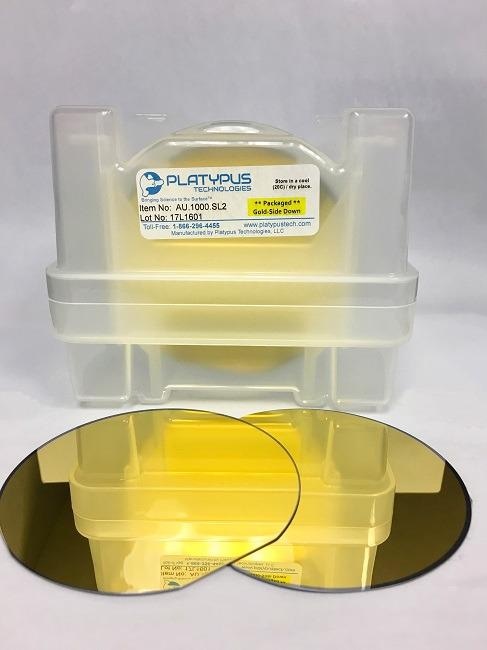Gold is obviously an incredibly valuable material, but its value in the combined fields of spectroscopy and microscopy extend far beyond the superficial. Gold thin films have useful optical properties when deposited uniformly onto transparent glass or mica, including selective reflectivity and transmissivity.
The gold-coated glass can be readily leveraged in a range of high-resolution imaging methods which push conventional optical limits, as long as the gold-coated glass can be engineered with extremely precise planarity at, or near, the atomic range.
Platypus Technologies routinely apply their revolutionary surface science expertise to provide top-quality gold-coated glass products for custom specifications.
They are constantly striving to create novel solutions for an ever-expanding range of spectroscopy and microscopy applications, especially in protein analysis and surface science applications.
Platypus Gold-Coated Glass: Characteristics and Qualities
Platypus provides gold-coated glass in three key formats, and microscope slides will be focussed on for the purposes of this article, but it should be considered that coverslips and gold-coated glass chips with comparative properties are also available.
The gold-coated glass slides from Platypus Technologies has engineered in a class 10,000 cleanroom via electron beam evaporation, allowing the deposition of gold thin films at extremely high purities (<99.999%).
Uniform adhesion is promoted by first plasma cleaning the glass substrate and applying an extremely thin layer of adhesive titanium to the surface.
Usually, the underlying substrates are aluminosilicate glass slides of 1 x 3 inches and 0.7 millimeters in thickness. The high purity coating process undertaken by Platypus Technologies allows them to produce atomically flat gold thin films of 10 nanometers (nm), 50 nm or 100 nm.
Applications of Gold-Coated Glass
The key benefit of their gold-coated glass slides for numerous imaging applications is their outstanding topographical uniformity.
Advanced imaging techniques go beyond the visible spectrum, unlike conventional imaging, where visible light is employed to illuminate and thus magnify samples for observation.
The atomic-scale uniformity of their gold-coated glass slides enables researchers to probe very minute structures or gather very weak signals with absolute confidence of negligible interference from the substrate itself.
The molecular adsorption dynamics of gold surfaces also make them ideal candidates for immobilizing proteins of interest for microscopic/spectroscopic observation. This has proven to be an empowering technique for identifying and characterizing nanoscale biomolecular structures.

Capture of solvent droplets from emulsion into 100 µm deep microwells. Image Credit: Platypus Technologies, LLC
Gold-Coated Glass from Platypus Technologies
Platypus Technologies make the most of their gold-coated glass slides on a custom basis, supplying precision solutions that provide highly repeatable results for a large scope of surface-enhanced optical methods.

This information has been sourced, reviewed and adapted from materials provided by Platypus Technologies, LLC.
For more information on this source, please visit Platypus Technologies, LLC.